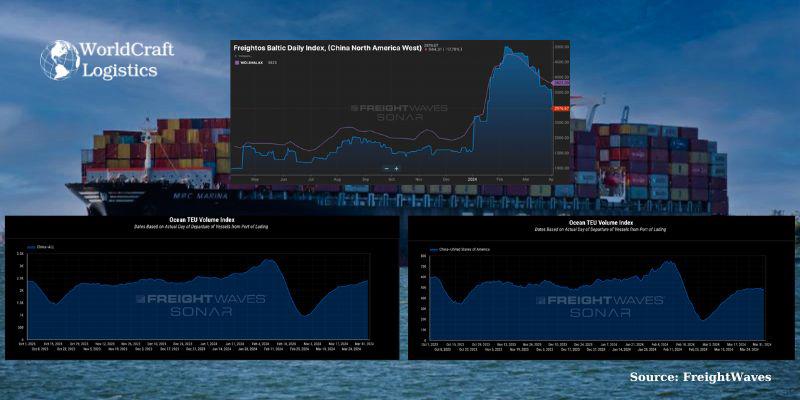
Starting June 1st, 2023 Our warehouse fee will be $0.65/cubic foot per month
In effort to lower the warehouse storage fee during inflation, we have went narrow aisle racking.This construction took us four months but the project is finally completed. With narrow aisle racking, we are able to drop storage by 24%.We as partners will go through this inflation together.
04/03/2024
Trans-Pacific ocean container spot rates headed east took another nosedive this week as container ship capacity along the route rebounds, with volumes settling at a lower level post-Lunar New Year festivities.
According to the latest figures from the Freightos Baltic Daily Index, spot rates from China to the West Coast of North America plummeted from $3,620 per forty-foot equivalent unit to ↓ $2,976 per FEU this week, marking a steep 17.8% decrease. This decline represents a significant slump of over 36% since March 1, attributed to the adjustment of steamship line networks and the easing of capacity amid the Red Sea crisis.
Similarly, the Drewry’s World Container Index, reflecting rates from Shanghai to Los Angeles, now sits at $3,825 per FEU, down from its peak of ↓ $4,771 recorded on February 8.

China's industrial sector is witnessing a resurgence, as indicated by the latest Caixin manufacturing purchasing managers’ index. On Monday, the index surged to 51.1, marking the fifth consecutive month of expansion, with 50 being the threshold. However, this growth, or rather the optimism surrounding it, has not translated into improved China-U.S. trade relations. Data from SONAR’s Container Atlas reveals a promising recovery in ocean container bookings departing from China to worldwide ports, reaching levels comparable to those before the Lunar New Year, with a particularly notable surge in bookings observed in the past week.
However, indications suggest that shipments to the United States, whether directly or indirectly, constitute a diminishing portion of the overall outbound container volume.
In a recent report by FreightWaves, it was revealed that Maersk openly acknowledges and even promotes its services aimed at assisting importers in circumventing tariffs by rerouting goods through Mexican ports before entering the United States. The gradual redirection of container traffic utilizing these services, coupled with enhancements in Mexican logistical infrastructure, could be contributing to the observed decline in shipment volumes from China to the U.S.
Steamship companies appear to be initiating measures to stabilize eastbound trans-Pacific rates, although the impact of these actions has yet to be significantly felt, according to additional data from the SONAR Container Atlas. Over recent weeks, the total capacity of twenty-foot equivalent units (TEUs) on routes from China to the U.S. has reached its peak and begun to decrease, dropping from 572,000 TEUs departing in the week of March 22 to just 427,000 TEUs departing from Chinese ports in the week of April 1. Concurrently, rejection rates have surged from 11.9% to 14.2% over a similar timeframe, while lead times have continued to normalize post-Lunar New Year, decreasing from a peak of over 17 days on Feb. 22 to eight days as of Tuesday. The reduction in capacity and increase in rejections suggest a marginal tightening of the market. Shorter lead times may be attributed to rebookings after rejections and heightened urgency among shippers to secure capacity, though an eight-day lead time still falls within the lower end of the 'normal' range.
The article was searched and edited by Jessica Ng according to the main information of FreightWaves newspaper. If you read comments or have special requests for this article, please contact WCL.
Here are some exclusive topics for readers, don't miss them:
👉 Q4 2023: See carriers lose EBIT of $1.44 billion
👉 The Port of Los Angeles is preparing to launch a $130 million Transportation Initiative
👉 Concerns about rising container shipping costs after the Red Sea incident
Content
I am working in-house at Worldcraft Logistics. With my experience as the position, I have written more than 200 knowledge sharing articles, edited new news sections and created interesting video content for the company's Tiktok and Youtube channels.

Hot News
08/05/2024

Hot News
02/23/2023

Hot News
02/23/2023

Hot News
02/06/2023
Hot News
02/07/2023